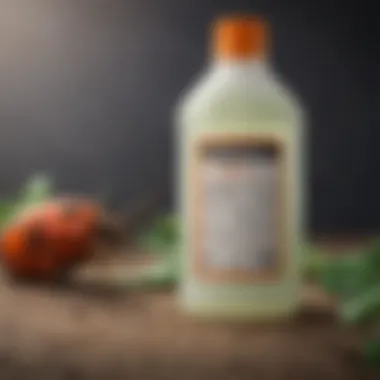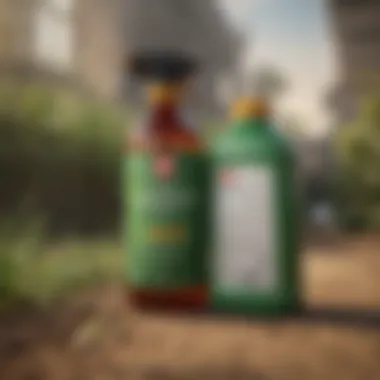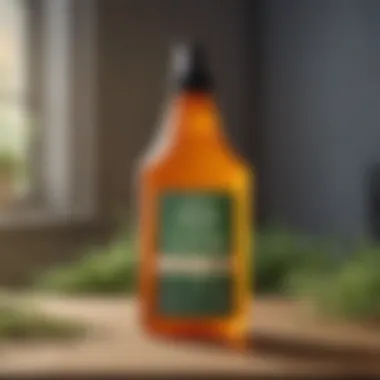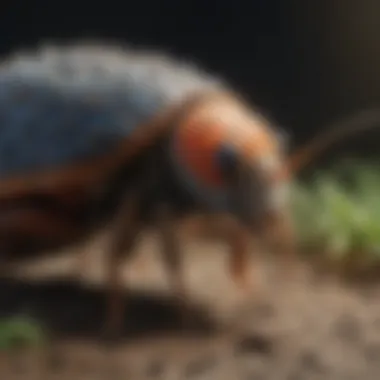Understanding the Termidor Insecticide Label


Intro
The comprehension of pesticide labels is crucial for individuals involved in pest management, especially homeowners seeking effective solutions. In particular, understanding the Termidor insecticide label is vital as it outlines important information about this widely-used product. This guide offers a thorough understanding of Termidor's components, application methods, safety protocols, and its role in effective pest management, specifically targeting termites and other pests.
Awareness of the details presented on the label can define the success of pest control measures and ensure safety during application. Each facet of the label is designed to inform users about the active ingredients, directions for safe use, and necessary precautions. The goal here is to clarify any misconceptions and aid in making informed decisions about pest control strategies.
Pest Identification
Knowing the specific pests you are dealing with is a fundamental step in any pest management strategy. Below are detailed descriptions of common pests and the signs of their presence in your home.
Detailed descriptions of common pests
- Termites: These wood-destroying insects often remain hidden until the damage is severe. They thrive in moist environments and feed on cellulose, found in wood and paper.
- Ants: Various species invade homes, often searching for food. They can be seen trailing in lines and may build nests inside walls.
- Cockroaches: They prefer dark, warm areas and are known to carry diseases. An unmistakable odor and droppings may signal their presence.
- Bed Bugs: Small, flat insects that feed on human blood. Signs include bites on the skin, dark spots on bedding, and shed skins.
Signs and symptoms of infestations
Intervention starts with recognizing signs of infestations. Common indicators include:
- Unexplained damage to wood, suggesting termite activity.
- Visible trails or nests of ants.
- Smudges or odor in areas where cockroaches frequent.
- Bed bug bites on exposed skin or dark spots on sheets.
A keen awareness of these signs can facilitate early intervention, which is critical for effective pest management.
Prevention Strategies
Preventing pests from entering your home is often easier than dealing with an infestation. Here are several strategies to keep pests at bay.
Home maintenance tips for pest prevention
- Ensure that all food is stored in airtight containers.
- Regularly check for leaks and moisture, as pests are attracted to damp areas.
- Seal cracks and crevices in walls and foundations to diminish entry points.
- Keep yard clean; maintain plants and remove debris to reduce hiding spaces for pests.
Natural deterrents and barriers
Natural solutions can also provide effective pest control. Consider the following options:
- Diatomaceous Earth: This natural powder can deter insects when sprinkled in areas they frequent.
- Essential Oils: Oils like peppermint or tea tree can repel many pests owing to their strong scent.
- Soap and Water: A simple mixture can suffocate insects on contact.
Treatment Options
When prevention fails, treatment becomes necessary. Understanding available options is key.
Overview of chemical vs. natural treatments
Chemical solutions like Termidor are formulated specifically for targeted pest control, particularly termites. They are effective but require careful handling. On the other hand, natural treatments are generally safer but may take longer to show results.
Step-by-step guides for DIY treatments
For those inclined to manage pests independently, here are brief guides:
- Using Termidor: Ensure to read the label for specific application directions, mixing instructions, and protective equipment recommendations.
- Natural Options: Mix soap with water in a spray bottle and apply directly to the pests; reapply regularly to maintain effectiveness.
Preamble to Termidor Insecticide
Understanding the Termidor insecticide is crucial for those involved in pest control, whether professionals or homeowners. This section provides an overview that sets the foundation for deeper knowledge regarding its uses and benefits. With pest infestations, particularly termites, posing significant challenges, knowing how to effectively address these issues becomes imperative. Termidor offers a solution, but its correct application and understanding of the label remain essential for efficacy and safety.
Overview of Termidor
Termidor is a widely recognized termiticide and insecticide used primarily for controlling termites and other pests. Its active ingredient, fipronil, acts on the nervous system of insects, providing an effective means to eliminate infestations. This product is often favored for its long-term residual control. Users find it vital to familiarize themselves with the specific dosage and application methods as listed on the label. Such understanding ensures the product performs as intended and adheres to safety guidelines. The label serves not just as a set of instructions but as a vital resource that informs users about safe handling, application timing, and environmental considerations.


Importance of Chemical Solutions in Pest Control
The demand for effective pest control solutions has increased significantly in modern homes. Chemical solutions like Termidor play a pivotal role in integrated pest management strategies. Their effectiveness stems from targeted action against specific pests, helping to minimize potential damages to property. For instance, termites can cause severe structural damage, which makes their eradication urgent. Chemical solutions provide rapid results compared to many organic methods. However, responsible usage is paramount. Understanding the label ensures that chemicals are used judiciously to mitigate potential health risks to humans and pets, as well as harm to beneficial insects in the ecosystem. The importance of leveraging chemical solutions cannot be overstated, provided the user is educated and compliant with regulatory standards.
Components of the Termidor Insecticide Label
Understanding the components of the Termidor insecticide label is crucial for effective pest management. The label provides essential information that guides users on how to safely and efficiently apply the product. Each section of the label serves a specific purpose, ensuring that homeowners and pest control professionals can make informed decisions about its use.
Active Ingredients
The active ingredients in Termidor include Fipronil, which is the primary component responsible for its pest control properties. Fipronil belongs to a class of chemicals called phenylpyrazoles. This chemical disrupts the normal functioning of insect nervous systems, leading to paralysis and death. The effectiveness of Termidor against pests like termites and ants is principally due to Fipronil's mode of action.
When looking at the label, users should pay close attention to the concentration of active ingredients listed. This concentration significant impact on efficacy and application rate. For example, lower concentrations may require a larger volume of the product to achieve the desired effect, potentially leading to increased costs and environmental impact.
Inert Ingredients
Inert ingredients listed on the Termidor label play an important role as well. These compounds do not possess pesticidal properties but are included to enhance the performance of the product. They can function as carriers, solvents, or emulsifiers, facilitating the distribution of the active ingredient once applied. Understanding these ingredients is vital, as they may affect the application process and the environmental profile of the insecticide.
Recognizing the nature of inert ingredients can help users assess potential interactions with other chemicals or environmental factors. Users should familiarize themselves with these components to ensure proper handling and application.
Signal Words and Safety Information
Signal words on the Termidor label serve as quick indicators of the product's potential hazards. Common signal words include "Caution," "Warning," and "Danger." Each word indicates a specific level of toxicity. For instance, "Caution" suggests the least risk while "Danger" signifies high toxicity levels that require immediate attention.
Reading the safety information, which accompanies these signal words, is essential. This section typically covers necessary precautions and protective measures. For instance, it may recommend wearing gloves, goggles, and long-sleeve clothing during application to prevent exposure to the skin and eyes. Documenting this information ensures a safer experience when using Termidor and contributes to overall pest control success.
Understanding the label information is not just about following directions; it is about ensuring personal and environmental safety while maximizing the insecticide's effectiveness.
In summary, recognizing and comprehending the components of the Termidor insecticide label is essential for effective use. The active ingredients provide the core efficacy, while inert ingredients enhance performance. Signal words and safety information ensure safe handling and application. Educated users can optimize pest management efforts by thoroughly understanding these elements.
Application Guidelines for Termidor
The application guidelines for Termidor insecticide are critical for ensuring both efficacy and safety. Proper application techniques can significantly influence the success of pest control efforts. Understanding these guidelines helps homeowners and professionals make informed decisions about their pest management strategies.
Pre-Application Considerations
Before applying Termidor, it is essential to assess the specific situation. Evaluate the area where treatment is needed. Make sure to identify the target pests and understand their behavior. This knowledge assists in deciding where and how to apply the insecticide effectively. Additionally, check the weather conditions to avoid rain shortly after application, as it can wash away the product. Choose a suitable method based on the type of pest and the location. Such considerations lay the foundation for a successful application and long-term pest control.
Recommended Application Methods
Different application methods exist for using Termidor. Each has distinct advantages and considerations suited for various situations.
Trenching Method
The trenching method involves digging a trench around the perimeter of the structure. This method allows for direct application of Termidor into the soil where termites often reside. One key characteristic of this method is its effectiveness in targeting subterranean pests. The trenching method is a popular choice among pest management professionals due to its thoroughness. However, it requires manual labor and can be time-consuming. The unique feature is that it creates a continuous barrier against termites, which can lead to long-term protection. Still, property owners should also consider the excavation required and ensure that the trench is at the proper depth to avoid any misapplication.
Surface Application
Surface application entails spraying Termidor directly onto the ground surface of the treatment area. This method is beneficial for treating large areas quickly. It is an effective solution for controlling pests that reside above ground. One of the key characteristics of surface application is its speed. It can cover a broad area in a short time and is often favored for residential properties. However, a unique feature of this method is that it may not penetrate deeply into the soil. This could decrease its impact on pests that dwell underground. Therefore, understanding the pest behavior in the area is crucial when deciding on this method.
Injection Technique
The injection technique involves using a device to directly inject Termidor into the soil at various points around the target area. This method is particularly suitable for localized infestations. A notable characteristic of the injection technique is its precision. It minimizes the amount of product used while targeting specific areas of pest activity. This method is beneficial for properties with landscaping, as it reduces disturbance to the environment. However, the unique feature is that it may not provide a comprehensive barrier unless multiple treatment points are used. Applicators should ensure a thorough understanding of the pest's movement to determine optimal injection locations.
Optimal Timing for Application
Timing is essential when applying Termidor. Ideally, it should be applied before infestations occur, often in early spring or late summer. Early application allows for preventive measures, while late application can address existing issues as pests seek shelter from temperature changes. Homeowners should also consider annual inspections to determine the best times for potential reapplication. In addition, rapid response to termite activity can prevent extensive damage and costly repairs.
Understanding and adhering to these application guidelines for Termidor contributes to effective pest management strategies, ensuring that efforts are both safe and successful.


Safety Protocols When Using Termidor
When using Termidor insecticide, adhering to safety protocols is crucial for ensuring not only personal well-being but also protecting the environment. These protocols help minimize risks associated with chemical applications. Proper understanding and implementation of these safety measures can enhance the efficacy of pest control efforts while safeguarding health.
Personal Protective Equipment (PPE)
Personal protective equipment is an essential barrier between the user and the chemical compound in Termidor. Wearing appropriate PPE helps to reduce exposure to harmful substances. Key components of PPE when applying Termidor should include:
- Gloves: Chemical-resistant gloves prevent skin contact with the insecticide.
- Mask or Respirator: Wearing a mask or respirator protects against inhaling vapors and particles, particularly in enclosed spaces.
- Goggles: Safety goggles shield the eyes from splashes.
- Coveralls: Long-sleeved shirts and pants or a coverall protect skin from overspray or exposure.
It is vital to select PPE that is specifically rated for chemical use. Following manufacturer guidelines ensures the highest level of protection for the applicator.
Environmental Safety Measures
Environmental safety measures are designed to minimize any negative effects on wildlife and surrounding flora during and after the application of Termidor. Some effective measures include:
- Buffer Zones: Establishing buffer zones around sensitive areas such as water bodies and gardens minimizes run-off contamination.
- Avoiding Windy Days: Application should not occur during windy conditions to prevent drift that might affect non-target areas.
- Proper Disposal: Empty containers must be disposed of according to local regulations to avoid environmental hazards.
Implementing these measures safeguards against potential ecological impacts, ensuring a responsible approach to pest control.
First Aid Procedures
In case of accidental exposure to Termidor, knowing the first aid procedures is necessary. Quick response can alleviate health risks. The following steps are recommended if contact occurs:
- Inhalation: If inhaled, move the individual to fresh air immediately. Seek medical attention if they experience difficulty breathing.
- Skin Contact: Remove contaminated clothing and wash the affected area with soap and water for at least 15 minutes.
- Eye Contact: Rinse eyes thoroughly with clean water for at least 15 minutes and seek medical help.
- Ingestion: If ingested, do not induce vomiting. Contact a poison control center or seek medical assistance right away.
Proper first aid can be crucial in mitigating effects of chemical exposure, highlighting the importance of preparedness.
Following safety protocols while using Termidor ensures effective pest management without compromising health or safety. Understanding the role of PPE, environmental precautions, and first aid procedures can lead to responsible applications that benefit both individuals and the surrounding community.
Regulatory Compliance and Restrictions
Regulatory compliance is a critical aspect when dealing with Termidor insecticide. Adhering to regulations ensures not only the safety of the applicator and public but also the efficacy and environmental integrity of pest control operations. Knowledge of regulatory compliance helps homeowners and professionals navigate the complexities of using chemical solutions responsibly, while maximizing their pest control efforts. Failure to comply with these regulations can lead to serious consequences, including environmental damage and legal repercussions.
Understanding Label Directions
The label on Termidor insecticide serves as a vital tool for users. It provides detailed instructions on how to properly handle and apply the product. This includes information on the dilution rates, application frequency, and specific areas of application. Ignoring the directions can result in ineffective pest control or, worse, harm to individuals, pets, and beneficial insects in the environment.
Important elements found in label directions include:
- Dosage Information: Knowing the right amount to use is essential.
- Storage Instructions: Proper storage prevents accidents and preserves the chemical integrity.
- Disposal Guidelines: Indicates how to dispose of any leftover product safely.
"Following label directions is not just a suggestion; it’s the law."
State and Federal Regulations
Both state and federal regulations govern the use of Termidor. These laws are designed to protect public health and the environment. At the federal level, the Environmental Protection Agency (EPA) oversees pesticide usage. State regulations may vary, and it is essential for users to be aware of local laws regarding pesticide applications.
Compliance with these regulations can include:
- Pest Management Certifications: Some states require applicators to be certified to apply pest control products.
- Notification Requirements: Some laws necessitate notifying neighboring properties prior to application.
- Record-Keeping: Detailed records of all applications may be required for inspections.
Reporting Requirements for Applicators
Applicators have specific reporting obligations to comply with regulatory standards. These requirements ensure transparency and safety in pest management practices. Applicators should be aware of the following:
- Incident Reporting: If any adverse effects occur, these must be reported to the relevant authorities.
- Application Logs: Keeping records of where and when Termidor was applied is often mandatory.
- Pesticide Use Reports: Some jurisdictions may require periodic submissions detailing pesticide use.


Effective reporting not only protects the applicator but also contributes to broader public health efforts. Understanding these elements forms a foundation for safe and effective pest control practices.
Effectiveness of Termidor in Pest Control
The effectiveness of Termidor in pest control is a crucial aspect of understanding its label and proper usage. As a widely recognized insecticide, it offers a targeted solution for managing various pest populations, particularly termites. Its mode of action is designed to disrupt the normal physiological processes of pests, making it an essential tool for homeowners and pest control professionals alike. This leads to a reduction in pest numbers, minimizing damage to structures and ensuring a healthier living environment.
Target Pests and Their Behaviors
Termidor specifically targets pests such as termites, ants, and certain other wood-destroying insects. Understanding the behaviors of these pests is vital for effective control. For example, termites often operate invisibly, traveling through underground tunnels or within walls, making them difficult to detect initially. Termidor works effectively because it can be applied as a barrier treatment, preventing termites from accessing food sources. Additionally, as termites come in contact with the chemical, they inadvertently spread it among their colony, leading to a broader impact than the initial treatment.
Comparative Analysis with Other Insecticides
When comparing Termidor to other insecticides on the market, several factors come into play. Many traditional insecticides rely on contact action, which requires insects to be physically exposed to the chemical at the time of application. In contrast, Termidor uses a unique non-repellent formulation, which means that pests do not sense its presence. This characteristic increases the likelihood that target pests will encounter it, allowing for more effective eradication. Overall, while other products may deliver immediate results, Termidor's long-term and colony-wide effectiveness places it at a distinct advantage in pest control.
Long-Term Efficacy and Residual Control
Long-term efficacy is one of Termidor's strong points. Once applied, it maintains its effectiveness for an extended period, often exceeding five years in many applications when properly utilized according to label directions. Residual control is particularly important in areas susceptible to pest re-infestation. Users can have confidence that Termidor will continue to serve as a barrier against future pest activity. Aside from its long-lasting properties, it also minimizes the need for frequent reapplications, thus making it both cost-effective and efficient over time.
In summary, Termidor's effectiveness is underscored by its targeted action against key pests, comparative advantages over other insecticides, and long-term residual solutions, making it a staple in pest management strategies.
Myths and Misconceptions About Termidor
Understanding the myths and misconceptions surrounding Termidor is crucial. This section aims to clarify inaccuracies that could influence a user's decision regarding pest control. It is vital for homeowners to base their choices on facts rather than false beliefs. Proper understanding can ensure effective application and better pest management outcomes.
Common Misunderstandings
Many homeowners hold assumptions about Termidor that can lead to misuse or ineffective applications. One prevalent misunderstanding is that Termidor is only effective against termites. While it is renowned for its effectiveness against these pests, Termidor also targets several other insects. Notably, it can manage ant infestations and other wood-destroying organisms.
Another common belief is that all insecticides are safe for indoor use. Although Termidor is highly effective, it is not necessarily safe for indoor applications in all situations. Always refer to the label for specific instructions. Misinterpreting the safety guidelines could potentially expose occupants to harmful chemicals.
Also, some people think that more product means better results. This is not true; following the manufacturer’s recommended dosage is essential. Overapplication can result in damage to the environment and less effective pest control.
Debunking False Claims
There are many claims about Termidor that do not hold up under scrutiny. One false claim is that Termidor remains effective indefinitely. In reality, like all insecticides, its efficacy diminishes over time, influenced by environmental factors such as rain and temperature.
Another misconception is that Termidor can harm beneficial insects, such as pollinators, indiscriminately. While it is true that Termidor affects various insect species, when applied properly and according to the label, risks to beneficial insects can be minimized.
In addition, some myths suggest that Termidor is overly complex to apply. While proper application is necessary to achieve optimal results, the guidelines provided on the label are straightforward. By following these instructions, homeowners can confidently use Termidor without undue complications.
"Understanding the facts about Termidor empowers homeowners to make informed pest control decisions."
In summary, distinguishing between fact and fiction regarding Termidor is essential. By addressing common misunderstandings and debunking false claims, we promote a better understanding of its role in effective pest management.
Finale
In evaluating the Termidor insecticide label, it becomes clear that understanding its complexities is crucial for both homeowners and pest control professionals. The label provides a wealth of information that guides users toward effective pest management while ensuring safety and regulatory compliance. Every section of the label, from active ingredients to application methods, embodies important elements that contribute to its efficacy in pest control.
Summary of Key Points
The key points discussed throughout this article underscore the significance of closely adhering to the Termidor insecticide label.
- Active Ingredients: Knowledge of the active ingredients enables informed decisions regarding effectiveness against target pests.
- Application Guidelines: Proper understanding of application methods prevents misuse and maximizes effectiveness.
- Safety Protocols: Utilizing personal protective equipment ensures user safety while handling chemical solutions.
- Regulatory Compliance: Awareness of compliance requirements emphasizes the need for responsible usage.
- Debunking Myths: Addressing misconceptions fosters a more informed community regarding pest management.
Each of these points reinforces the need for accuracy and vigilance in pest control practices.
Future Perspectives on Pest Control Solutions
Looking ahead, the field of pest control is likely to evolve with advancements in technology and biology. As homeowners become more aware of ecological impacts, there is a growing demand for sustainable pest management solutions.
- Increased Use of Eco-Friendly Products: Future solutions may emphasize non-chemical alternatives to synthetic insecticides like Termidor.
- Integrated Pest Management (IPM): Focus on IPM methods will affect how chemical solutions are employed, enhancing overall pest control effectiveness.
- Data-Driven Decisions: Advances in data analytics might allow for precision pest control, optimizing application timing and dosage based on pest behavior patterns.
The discussion around pest management solutions will continue to prioritize safety and efficacy. As regulations evolve, staying informed will be essential for successful pest control strategies.
"A well-informed approach to pest management benefits both users and the environment."



